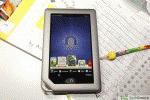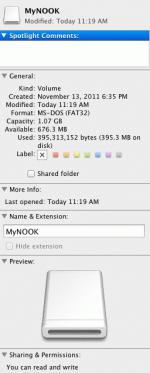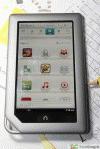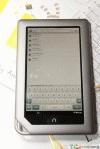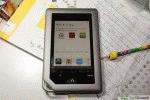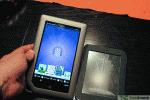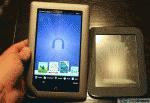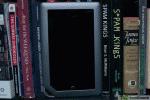
The Short Version
In the mad rush to push out more and more Android slate products, Amazon and Barnes & Noble are like a calm port in the storm. Their devices are touted as ereaders but, after a bit of digging, you find that they are now considerably more interesting – and compelling – as tablet products for an entry level market. They are not threatening nor are they particularly difficult to grasp. In short, they are the perfect neophyte’s tablet, a cross between the simplicity of an e-ink ereader and a fully-featured mobile device. It’s good enough at both that people buying it for one purpose will be pleased with the device’s other strengths; depending on what you want, it’s either an Android slate in ereader’s clothing or vice versa.
Amazon’s new Fire, which we’ll review shortly, takes a certain tack – low-priced, cloud oriented content consumption – while the Nook Tablet takes a decidedly different one. Priced at $249 – still cheaper than even the least-outfitted Android tablet – and aimed at a slightly more techie audience, the Nook Tablet is an ereader first and a tablet second.
As it stands, the Nook Tablet is an impressive bit of machinery. It is a solid slab of electronics designed to do a few things exceedingly well and – sadly – a few things quite poorly. As a color, touchscreen ereader it is one of the best and, for those with an adventurous bent, I can imagine this becoming a useful media and app device.
The Nook Tablet is a tablet for everyone. It is solid, easy to use, and most of Android’s rough edges have been burred off. Although there are some odd UI choices and frustrations, everything is in its right place. It is, in short, a perfectly slimmed down Android tablet masquerading as an ereader – something many will prefer over Kindle Fire’s obviously service-oriented approach.
Features:
- 7-inch color display
- MicroSD card slot for storage
- Video and audio playback
- 1GHz TI OMAP4 (dual-core) processor with 1GB RAM
- MSRP: $249
Pros:
- Light and portable
- Long battery life
- App sideloading is possible
Cons:
- Odd storage usage leaves you with about 1GB of personal space
- No dedicated video player
- Some issues with PDF display
What Is It?
The device has a 7-inch touchscreen that is surprisingly bright and readable. The front panel is grey plastic and the edge of the device is made of silver plastic. There is a small notch taken out of the lower left corner, something that I assume is useful of you wish to attach a lanyard to this thing. The back is the most pleasant aspect of the device. The soft touch plastic feels quite a bit like soft leather or suede.
There are exactly four buttons – a central home button, shaped like the Nook N, a power button on the upper left and two volume or control buttons on the right. There is a microUSB port at the bottom and a small flap that pops up near the notch where you can fit a microSD card. There is a speaker grille at the bottom and a small hole for a microphone at the top. Finally, there is a headphone jack at the top.
To power it on you simply hold down the power button. It boots in about a minute and starts back up in about 2 seconds. There are small audio cues for the various functions, including plugging into the USB cable and unlocking and locking the device. These can be turned off.
There is no camera.
The Nook Tablet is a direct descendent of Barnes & Noble’s Nook Color. As the name states, it’s a tablet, but not in the PC sense. The branding and UI points to the more primordial view of “tablet,” which suggests that this device is more like a cuneiform tablet to an early scribe than anything Bill Gates held up as the future of computing in 2001. However, the use of the word “tablet” is important in marketing this device. At $249, it can be perceived as being far more expensive than the Kindle Fire (although it’s not) and by naming the “Tablet” rather than the “Slate” or the “Runik Booke,” B&N is ostensibly saying “This is a computing device that we made for readers.”
When you connect the device to a Mac or PC, the onboard storage appears. If you add a microSD card, this card also appears as a separate drive, something that could be confusing to new users. The device automatically sets up a certain number of folders for B&N use as well as your private use and it scans those folders each time you unplug the device.
The device comes with 13GB of space available but there is, as they say, a rub. As you see here, the “MyNOOK” disk appears to only have 1GB available. The rest of that space is taken up by the Nook software and content. Quoth the website:
1GB = 1 billion bytes. Actual formatted capacity may be less. Approximately 13GB available to store content, of which up to 12GB may be reserved for content purchased from the Barnes & Noble NOOK Store.7microSD™ or microSDHC™ memory cards sold separately. microSD and microSDHC are trademarks of SD-3C
This means you simply must install a MicroSD card, a prospect that many might find onerous. However, if you’re not planning on dragging MP4 movies onto this thing, you might be able to scrape by. If there is any major flaw in this device it is this odd problem of disk usage.
B&N will offer digital video rental and downloads “early next year” which is why this space has been roped off. The magazines and other rich content are apparently also large files, said a B&N spokesperson, so that space has been dedicated to “official” content rather than side-loaded ad hoc content.
Usability
The Nook Tablet UI is fairly straightforward. After sliding to unlock the main screen, you’re presented with a carousel of books and items you’ve recently used. You can drag these to the main screen much like apps in any Android phone and they remain persistent there. Along the bottom is a row of small icons – Books, Newsstand, Movies, Music, Apps – and there are small icons signifying the microSD card and the book you’ve just read. Up in the top corner of the home screen is the “More” menu that supplies possibly interesting items for your consumption.
The music player is nearly stock Android and the media player lumps photos and video into one app, a frustrating experience. However, everything else is fairly custom, from the epub/PDF reader to the app store.
Searching for apps is slightly frustrating. Because the Nook App Store is limited by B&N, looking for common apps like “Rockplayer” is almost impossible, returning instead a list of books with those words in the titles.
Browsing through the device is quick and clean. There is some of the old “Android lag” – pages move a bit too slowly, apps take a bit to spin up, but generally all of the reading experiences are more than adequate and the various apps available run as they would on any modern tablet.
The browser is just that – an Android browser with Flash Player 10.3.186.6 installed. I was able to browse TechCrunch in its full, Flash-enhanced glory while some sites exhibited some quirks associated with mobile browsers including failing to load backgrounds and defaulting to mobile versions of the site. The browser has a bookmarks feature as well as most visited and history tabs.
The device allows you to link your Facebook, Twitter, and Google accounts via the social settings tab. Facebook and Twitter allow for text sharing with the world at large while Google connectivity allows you to add your contacts as Nook friends. You can get recommendations from your friends using a feature called Nook friends, although this feature is somewhat muted in this version of the Nook software.
As I said before, this OS takes the edge off of Android but folks familiar with the OS will see most of the similarities. It is, to be clear, eminently usable and anyone – from an Android hacker to my mom – would be able to easily buy, read, and share books and some media.
Reading
First and foremost, this is an ereader. The screen is bright and crisp and when reading epub documents the formatting is unimpeachable. It is a backlit screen so outdoor reading is possible but not encouraged.
As a reader, the Nook Tablet works quite well. Books are as you’d expect and you can control the font size and orientation. Magazines really shine on this device. Issues of National Geographic and Food + Wine looked amazing on the bright, clear screen and the magazine reader was really quite nice – it could replace iOS’ newsstand for me if enough titles become available.
Comics appear just like magazines, with big, bright, and bold colors. If anything, the Nook excels at this sort of content.
Another fun feature is the built-in “read along” features for children’s books. I read a page of The Elephant Child into the device’s microphone and my kids can then pick my recording from an onscreen menu. The audio is actually recorded right onto the device and is available in M4A format for later download, which makes it useful for folks who might want to record junior reading a book.
When it comes to reading on this device the central question is whether you want the bright, bold colors of the Tablet or the muted – but more readable – e-ink display on the Nook or Kindle Touch devices. If you’re only reading on this thing, I wonder if you wouldn’t be better served by an e-ink device. However, the color screen adds considerable depth to the standard reading experience and has much to recommend it.
Video, Images, And Music
Now for the secondary functions. Barnes & Noble want this device to exist as an “HD media” player, which is a noble goal though, at 1024×600, B&N’s interpretation of “HD” differs considerably from the rest of the humanity’s. If by HD media they mean the ability to view videos on a fairly large, fairly bright screen, then why don’t they just say it?
Aside from this obviously malarkey, viewing videos on this is a dream and, coupled with an SD card and plenty of MPEG4 rendered content, you have something akin to what the iPod Touch was a few years ago – a capable device that you can take with you on the plane to watch a few movies.
Amazon’s Fire is all about the cloud. I’m pleased that this device is less about the cloud and more about content that is right on your device. Streaming movies is usually impossible on flights and in certain situations, sans Wi-Fi, so unless you plan on doing all of your watching at home there’s little to be said about files in the ether. Granted, both the Kindle and Nook have plenty of storage for downloaded content, but Amazon’s is a bit more tied into their own store than I particularly like.
If you must use the cloud, the Nook Tablet supports Netflix, Hulu Plus, and Showtime and should support other apps down the line. For music you have Pandora, Rhapsody, and Grooveshark although I was wildly sad to find Rdio and Spotify missing (although I did find a book called Spotify For Dummies, which shows you the problem with a unified book/app search).
It’s too soon to assess battery life but in my time with the device I didn’t notice much of a drain while watching video vs. simple reading.
The onboard speaker is more than sufficient in a small, quiet room but you wouldn’t want to be stuck listening to it for long.
Who Is It For?
So who wants this thing? Well, anyone who has used a Nook before, prefers Barnes & Noble over Amazon, and is looking for a device to partake in simple content consumption.
The Nook Tablet isn’t for everyone, however. If you are, for example, a big reader and are simply looking for something to stuff into a briefcase for a long plane ride, I think you will be better served by a device like the Nook Simple Touch or Kindle Touch. iPad owners will probably find much of the functionality duplicated here although the size and screen are a bit more manageable than the iPad’s.
If you’re looking for a less expensive but carefully curated media experience – with the backing of Barnes & Noble – this is probably the device for you. With the arrival of video rentals and downloads as well as the music apps, you’ve got an ereader with extras.
As a bonus, the Nook Color – and, eventually, the Nook Tablet – has a very rich modding community around it. Many of the limitations I mentioned above are already being circumvented and it’s only a matter of time before this device begins running modded firmware. Like all Android devices, there is more than meets the eye.
Bottom Line
As I said before, the Nook Tablet is an ereader with extras. You’re looking at a nice media device that also displays books. It has a few near-fatal flaws, but those can be remedied by the tech-savvy and ignored by everyone else. As it stands it is a strong and impressive improvement to the underpowered Nook Color and it is probably one of the better Android tablets I’ve used. Whether you go Nook or Kindle is actually a matter of preference for the parent companies as the hardware is nearly identical and most ways and if you already have a great deal invested in B&N content, this is a worthy and exciting upgrade to anything you’ve used in that family thus far.
